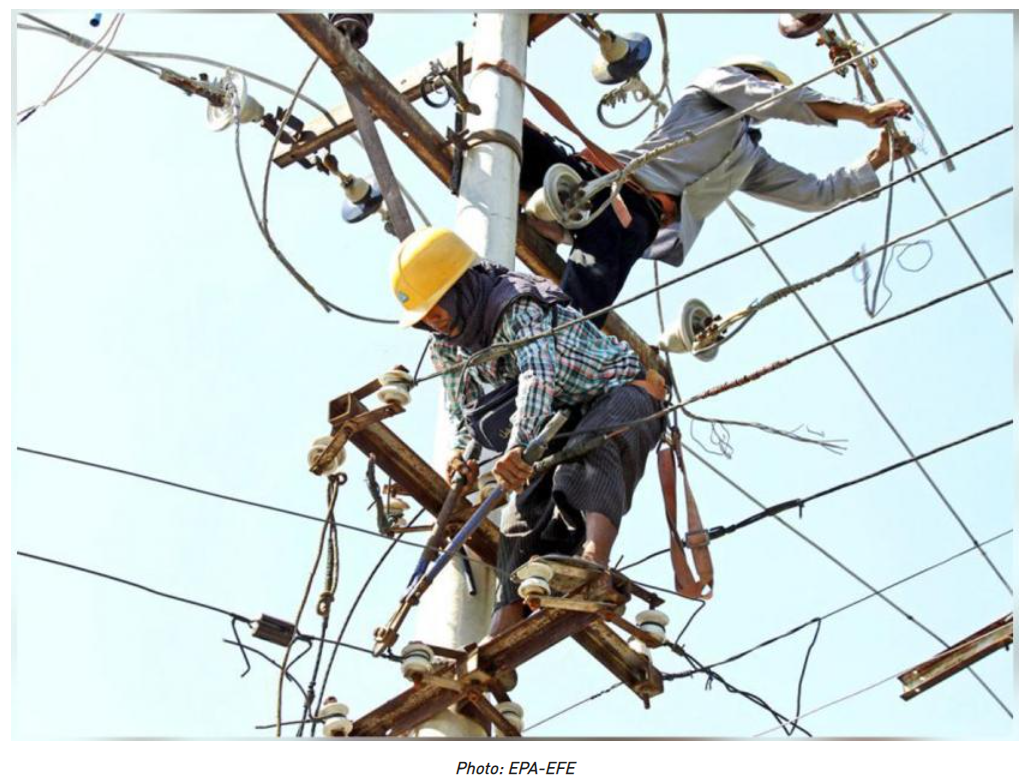Myanmar’s electricity losses shrink; more investments, spending needed to meet demand
Losses on electricity subsidies in Myanmar are likely to have declined to just about a third of levels seen before tariffs were raised in July 2019, U Tin Maung Oo, permanent secretary of the Ministry of Electricity and Energy, told journalists at the government’s fourth year performance review in Nay Pyi Taw on June 8.
The current losses are partly as a result of the government providing the first 150 units of electricity free of charge to households in April and May as a form of relief from COVID-19. The State forked out K35 billion to provide some 4.5 million households with electricity subsidies in April, U Zaw Htay, Director General of the Ministry of State Counsellor’s Office, said last month.
Myanmar also generated more power through natural gas this summer, which drove up costs. The country is expected to incur losses of between K100 billion and K200 billion this year compared to losses of nearly K700 billion before the tariffs were raised, U Tin Maung Oo said.
While the losses are narrowing, production costs are also expected to increase going forward as more spending will be required to meet the rising demands of an emerging economy.
Rising costs
In Myanmar, electricity is mainly generated by hydropower, which is the cheapest way to produce power. Moving forward though, a larger portion of Myanmar’s electricity needs are likely to be generated by gas and solar, which is more expensive to produce.
As a gauge, the cost to produce one unit of power is about K12 per unit at state-owned hydropower plants, U Tin Maung Oo revealed. This rises to about K72 per unit at privately-owned plants.
In comparison, the cost of producing one unit of power at a gas-fired power plant is between K150 and K190 per unit. The cost per unit of electricity generated by solar-powered plants costs about K195 per unit.
Currently, hydropower accounts for nearly 54 percent of the country’s electricity requirements while 41pc is generated by natural gas power plants. The remaining 3pc is generated by coal, diesel and solar.
Recently though, more power is being generated by gas, as water levels at the country’s dams are declining as a result of recent low rainfalls and new hydropower projects are facing delays in getting off-ground.
Last week, Malaysia’s state-owned oil and gas firm Petronas delivered 190,000 cubic meters liquefied natural gas (LNG) to Myanmar which will be used to power two plants in Thaketa and Thanlyin in Yangon, generating a total of 750 megawatts of electricity.
It was the first time an LNG tanker has successfully delivered LNG to Myanmar. The deliveries were made on a free-on-board basis as part of an agreement made earlier this year between Petronas subsidiary Petronas LNG Ltd and Chinese company CNTIC VPower, which last year won four power generation projects in Myanmar.
Raising long term production
The government will invest further upstream to produce more offshore gas to meet Myanmar’s longer term electricity needs and as gas production at existing fields decline.
Myanmar currently produces natural gas from its Yadana, Yetagun and Zawtika gas projects, but volumes have been dwindling. “As the local gas production rate declines, we have arranged to acquire LNG in short term and will try to boost offshore natural gas production for longer term needs,” U Tin Maung Oo said.
Last month, U Htay Aung, permanent secretary of the Ministry of Electricity and Energy (MOEE), said Myanmar will launch an international bidding round for oil and gas exploration this year, after amending the terms and conditions of the Production Sharing Contracts to draw more investors.
Other sources of energy will also be tapped. On May 18, the MOEE invited companies to bid for the construction of 30 ground-mounted solar plants capable of generating 1060MW of power under a 20-year build, operate and own basis.
Funds to help Myanmar raise its power generation capacity from international development partners are also trickling in. Just last month, the World Bank approved US$350 million in International Development Association (IDA) credit to help the country meet a national goal of providing each citizen with access to electricity by 2030.
Myanmar must double its power production capacity in the next 5-7 years to meet that goal. Only half the households in Myanmar are currently connected to the national grid, which is the lowest population with access to electricity in Southeast Asia, said Mariam Sherman, World Bank Country Director for Myanmar, Cambodia and Lao PDR.
The loan will be channeled towards the second phase of Myanmar’s National Electrification Project (NEP). Under Phase 2, power will be distributed to 4,700 villages, within five miles from the main power line in Regions and States such as Kayah, Kayin, Chin, Mon, Rakhine, Shan, Mandalay, Sagaing, Bago, Ayeyarwady, Yangon and Magwe.
The second phase is expected to be completed in September 2021, said U Zarni Tin Moe, chief engineer of the NEP.
In Phase 1, over 5,000 villages were connected to the national grid and some 7,200 to solar and small power stations, resulting in 2 million people now having access to electricity, data showed.
Source: https://www.mmtimes.com/news/myanmars-electricity-losses-shrink-more-investments-spending-needed-meet-demand.html


 Thailand
Thailand




